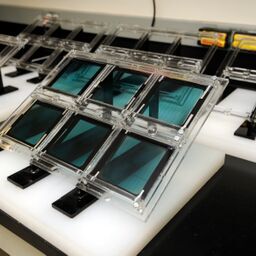Share This
Related Posts
Tags
Solar Surfaces
By Cutright Elizabeth on Nov 14, 2016 in Technology

Photo courtesy SB Independent
A revolutionary new technology can put solar cells on almost any surface, transforming traditional solar energy installations and turning buildings into power generators.
Rising up from suburban sprawl like the mythical Oz, the downtown business district of any major metropolis repeats a familiar scene: high-rise office buildings, covered in windows, reaching for the sky.
Skyscrapers may typify city skylines, but all that reflective glass also represents an incredible opportunity. Imagine harnessing all that surface area by converting those reflective surfaces into powerful solar arrays. That’s the idea behind Santa Barbara-based startup Next Energy Technologies groundbreaking solar technology.
Surface Generation

Photo courtesy SB Independent
Currently, buildings account for anywhere between 40-50% of total global energy use and over half of all CO2 emissions. In addition, electricity represents one of the largest variable operating expenses building owners face, accounting for as much as 20-25% operational budgets. Many facilities successfully reduce consumption by incorporating renewable energy onsite and energy efficiency strategies like LED lighting and energy management systems.
But what if the buildings themselves could generate power?
The concept is deceptively simple: use transparent solar cell ink to print photovoltaic cells directly between standard dual-pane windows. The genius lies in the execution. For Next Energy founders Daniel Emmett and Corey Hoven, it’s all about making solar efficient, customizable and inexpensive.
Windows Transformed
“The most important difference with our technology is the transparency,” Hoven explains. “While all other solar cells are opaque and absorb all visible light, the windows that use our system look like conventional windows. They can allow the visible spectrum to get through, which makes our solar cells highly efficient without changing the appearance or functionality of the window.”
Tinted windows can help manage indoor temperatures and lessen heating and cooling costs, but adding a solar component ups the ante by allowing any building to become an alternative energy powerhouse.
“All solar panels are basically ‘windows’ because they all use one or two pieces of glass to encapsulate them and protect them from moisture, which significantly impacts the cost of solar installation,” explains Hoven. “By printing in the window, our technology becomes part of the encapsulation process and is the funds already allocated to window framing and installation.”
“Instead of adding to the cost of the building, we are able to use glass that the building owner was already going to pay for which helps to reduce our costs making us the lowest cost solar technology in the world. Likewise, we reduce balance of system costs such as framing and labor that are already sunk into the costs for the window.

Photo courtesy SB Independent
Next Energy’s windows also stand out because of their carbon-based semiconductors. Unlike typical semiconductors, which are opaque forcing them to be deployed in patterns, carbon-based semiconductors are essentially translucent.
“Carbon-based semiconductors absorb UV and IR light and convert it to electricity while allowing sunlight to pass through the panel,” elaborates Hoven. “In that way, we get highly efficient solar cells that can cover an entire window and generate more power.”
Flexible and Cost-Effective
With the capability of providing windows in different colors and transparencies, Next Energy can also offer customization based on a structure’s strengths and weaknesses. For new buildings, Next Energy can work with architects and developers to analyze local environmental elements – including elevation, orientation and weather – and propose concrete solutions for optimized system performance.
“Up to now, this type of adaptable solar technology hasn’t been available,” says Emmett. “We can now work with architects, designers, developers and building owners to provide functional and flexible solar. It’s really an enabling technology.”
For developers and business owners focused on the bottom line, Next Energy’s ROI is particularly appealing. Emmett estimates a one-year payback and possible power generation of up to 100% depending on a building’s energy needs along with other factors like size, location and demand.

Photo courtesy SB Independent
“This is because of the fed tax credit of 30%, combined with energy generation and accelerated depreciation,” explains Emmett. “Those three things taken together more than offset the additional cost of windows. Even without tax credit, there’s still a really compelling return on investment.”
Harnessing the facades of commercial buildings to produce solar power also significantly reduces electricity costs by generating power during peak hours.
“By having onsite power coming from your façade, you can reduce load and offset grid demand,” he says. “Our technology addresses the challenge faced by commercial buildings who must use energy during the most expensive time of the day.”
From Concept to Commercialization
Hoven began his quest while working as a graduate student and postdoctoral researcher at UCSB. UCSB Professor, and 2000 Nobel Prize Winner, Alan Heeger has been a leading force behind the development of organic semiconductors, which form the basis of Next Energy Technologies’ small-molecule technology. “
“Professor Heeger is a brilliant man,” says Hoven. “Without that original of conception based on his Nobel Prize winning work, we wouldn’t be here.”
“His work paved the way and inspired what we’re doing,” adds Emmett.
Already the beneficiaries of over $3 million in government grants, Next Energy Technologies is more than halfway to its $7 million Series B funding objective. The next step involves progressing from research to commercialization, a goal Hoven and Emmett plan to reach by 2018. The ultimate social impact of Next Energy’s technology could reach as high as $7.4 billion, or over $300 for every dollar invested.
“It’s a cumulative effect,” clarifies Emmett in regards to that $7.4 billion sum. “Our technology has the potential to eliminate 570 million metric tons of carbon over three decades, and that’s a conservative estimate. The average gigawatt hour of electricity represents 600 metric tons of carbon emission, so you can see the total impact is huge. At $40/ton cost of carbon, you can see the total impact is huge in terms of how many gigawatt hours of carbon emissions can be avoided.”
By converting buildings from power user to power generator, Emmett and Hoven believe Next Energy Technologies can make buildings part of the solution to the world’s energy crisis.
“Up to now there hasn’t been a technology that generates solar power from windows while also satisfying the needs of the building owner and residents, especially in the commercial space,” explains Hoven. “It’s really an enabling technology.”
“We’re going somewhere where other solar cells can’t,” concludes Hoven, “and we’re doing it at a substantially lower cost. It’s game changing.”
